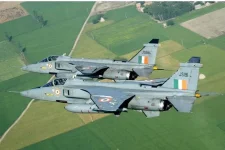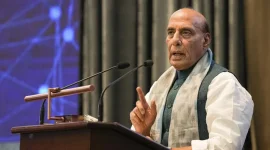- Views: 415
- Replies: 16
The Indian Air Force (IAF) faces a significant operational challenge, raising concerns about its preparedness to defend against potential threats from both China and Pakistan simultaneously.
Defence analyst Shashank Singh, associated with Caravan magazine and Yale University, recently detailed the extent of this challenge, describing it as a "very, very serious" situation stemming from multiple factors including reduced squadron numbers, aging aircraft fleets, shortages in essential support systems, personnel gaps, and policy issues.
A primary concern is the IAF's combat strength. Officially authorised to have 42 squadrons, the force currently operates with only around 31. This represents a shortfall of over 25%.
Defence experts like Ashley Tellis estimated back in 2016 that India required 60 squadrons for credible defence against a combined China-Pakistan threat, a number far higher than even the authorised strength.
Recent reports suggest the effective strength may be closer to 29 squadrons, as the last two MiG-21 units are scheduled for retirement by 2025. Furthermore, the Jaguar fleet, now the oldest fighter type following MiG-21 phase-out and retired by air forces like the UK's RAF years ago, faces obsolescence and spare parts issues, though upgrades aim to keep it operational until its phased retirement planned between 2027 and 2040.
Modernisation efforts appear slow. India's last major acquisition of modern fighters was the 2015 deal for 36 Rafale jets. A subsequent proposal from 2018 to procure 114 new medium multi-role fighter aircraft (MRFA) under the 'MMRCA 2.0' tender has seen little public progress, although recent reports suggest the government aims to fast-track the process, potentially inviting bids this year.
Meanwhile, regional capabilities are advancing; China displayed sixth-generation prototypes in late 2024, while India's own fifth-generation project, the Advanced Medium Combat Aircraft (AMCA), targets induction around 2035 after a first flight projected for 2028.
With Pakistan sourcing approximately 80% of its defence imports from China, there are concerns it could gain access to advanced Chinese aircraft within the next five to six years, potentially altering the regional air power balance before India's AMCA is operational.
Beyond fighter aircraft, Mr. Singh highlighted critical deficiencies in 'force multipliers'. These include airborne early warning and control systems (AWACS), aerial refuelling aircraft, electronic warfare platforms, drones, and advanced surveillance assets.
The IAF operates only three Phalcon AWACS and three indigenous Netra AEW&CS, alongside just six IL-78 mid-air refuellers acquired over two decades ago, despite assessments suggesting a need for significantly more (potentially 18 refuellers).
While projects for additional indigenous AEW&CS (Netra Mk1A and Mk2) are underway, the current limited numbers restrict the operational range and effectiveness of the existing fighter fleet. Alarmingly, Pakistan reportedly operates more AWACS and refuellers than India.
Personnel issues also affect the IAF. A Comptroller and Auditor General (CAG) report previously indicated a pilot shortage nearing 600 by 2021, with annual training intakes falling short. While the current aircraft shortage might mask the immediate impact, this deficit could become acute as new aircraft are eventually inducted.
Additionally, reports citing retired officers suggest only 50-55% of the IAF's aircraft are typically available for operations at any given time due to maintenance requirements.
The Agnipath recruitment scheme, introduced in 2022, presents further challenges according to analysts. Its four-year tenure, after which 75% of recruits are demobilised, is seen as insufficient for developing the highly specialised skills needed to operate and maintain complex IAF systems.
Senior retired military officials, including former Air Force and Navy chiefs, have voiced criticisms, and the IAF reportedly opposed the scheme initially. There are concerns this could lead to a lack of adequately experienced personnel within the next decade.
Structural reforms, such as the creation of integrated theatre commands, also face hurdles. The IAF has expressed reservations, arguing that dividing its limited assets (currently 31 squadrons) across geographically defined commands would reduce flexibility and dilute combat power. It advocates for centralised control, viewing India as a single air theatre due to its capacity for rapid nationwide redeployment.
These differing perspectives have contributed to delays in implementing the theatre command structure, although the government passed the Inter-Services Organisation Act in 2023 to facilitate jointness.
Financial constraints compound these issues. India's defence expenditure as a percentage of its Gross Domestic Product (GDP) is reported to be around 1.9% for the 2025-26 fiscal year (amounting to Rs 6.81 trillion), a level considered historically low by experts who argue for at least 3% given the strategic environment.
With a large portion allocated to salaries and pensions (Rs 1.61 trillion for pensions alone in the FY26 budget), funding for modernisation, particularly for costly fighter aircraft, remains tight.
While a significant deal with the US company General Electric for F414 engines to power the indigenous Tejas Mk2 and initial AMCA aircraft is reportedly close to finalisation, broader acquisition plans face budgetary pressures.
The gravity of the situation is underscored by public acknowledgements from Air Chief Marshal AP Singh regarding the capability gaps and the existence of a classified government committee report addressing the shortfalls.
Mr. Singh warned that without urgent corrective measures – including increased funding, diplomatic efforts for acquisitions, and faster modernisation – the IAF might struggle to fulfil its role effectively in a potential conflict within the next five to six years, potentially leading to a "catastrophic scenario."
Critics argue that the government, despite its long tenure, has not adequately addressed the developing crisis. The lack of recent fighter acquisitions and slow progress on existing plans necessitate immediate, concrete steps within the current financial year to bolster the IAF's operational readiness and avert future vulnerabilities.



